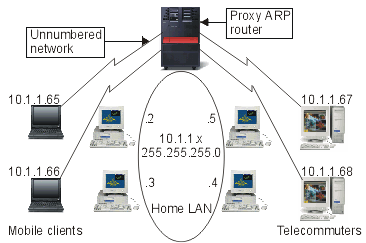Proxy Address Resolution Protocol (ARP) provides connectivity between physically separate networks without creating any new logical networks and without updating any routing tables. This topic also contains a description of transparent subnets, which is an extension to the proxy ARP routing technique.
ARP routing allows physically distinct, separate networks to appear as if they were a single logical network. It allows systems that are not directly connected to a LAN to appear to other systems on the LAN as though they are connected. This is useful in dial-up scenarios to provide connections to the entire network from a dial-in interface. The following figure shows a possible scenario. The 10.1.1.x is your home LAN and the 10.1.1.65 through 10.1.1.68 are your remote systems.

When a system on your home LAN (10.1.1.x) wants to send data to one of your remote systems, it will first do an ARP request. This is a broadcast that goes out to all your systems attached to the LAN segment to request the address of the target system. However, a remotely connected system will not see the broadcast. This is where the proxy ARP comes in. The iSeries™ server knows which systems are connected remotely. If your iSeries server sees an ARP request for one of your remotely connected machines, your iSeries server will reply to the ARP request with its address. Your iSeries server in turn receives the data and forwards it to the remote system. For this forwarding to take place, IP forwarding must be set to *yes. If your remote system is not connected, your iSeries server will not reply to the ARP request and the requesting system will not send data.
You can use transparent subnets as a proxy for an entire subnet, or range of hosts. Transparent subnetting allows stub networks to be assigned addresses out of the primary network address space.